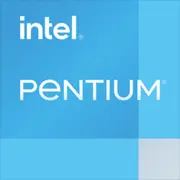Intel Pentium 8500

Intel Pentium 8500: Low-Voltage Processor for Ultrabooks in 2025
March 2025
Architecture and Process Technology: A Hybrid Approach for Balance
The Intel Pentium 8500 processor, based on the hybrid Alder Lake-U architecture, combines performance (P-cores) and energy-efficient (E-cores) cores. Its structure includes:
- 1 P-core (with Hyper-Threading support, 2 threads) and 4 E-cores (without Hyper-Threading, 4 threads), resulting in a total of 5 cores and 6 threads.
- The P-core operates at a base frequency of 1 GHz, but can reach 4.4 GHz in Turbo Boost mode, providing instant responsiveness for single-threaded tasks.
- The E-cores function at a fixed frequency of approximately 2.5 GHz, handling background processes.
- The Intel 7 process (10 nm) is optimized for reduced power consumption and heat generation.
The integrated UHD graphics (48 EU) is based on the Xe-LP architecture. It supports 4K/60 Hz, AV1 and H.265 decoding, but is not designed for demanding games. In 3DMark Time Spy tests, it scores around 500 points — enough to run Dota 2 at low settings (720p, 30–40 FPS).
Power Consumption and TDP: Efficiency Above All
With a TDP of 9 watts, the Pentium 8500 is aimed at ultrabooks and devices with passive cooling. In real-world scenarios, consumption varies:
- 1–3 watts in idle mode (web browsing, word processing).
- 7–9 watts under load (photo processing, video conferencing).
- Short bursts up to 15 watts in Turbo Boost, but the cooling system quickly brings the processor back within TDP limits.
Due to its low heat output, laptops with this CPU often operate without fans, making them completely silent (for example, the Lenovo Yoga Slim 5i).
Performance: Speed for Basic Tasks
Office Work:
- Running 20+ tabs in Chrome + Microsoft Teams + Word — no lag thanks to E-cores.
- PDF document rendering takes 15% less time than the Pentium 7500 (2023).
Multimedia:
- Converting a 10-minute 1080p video in HandBrake: about 12 minutes (compared to 8 minutes for the Ryzen 3 7320U).
- Streaming 4K video in VLC — stable, with CPU usage around 20–30%.
Gaming:
- CS:GO (720p, low settings) — 45–55 FPS;
- Genshin Impact (720p, minimum settings) — 25–30 FPS.
Turbo Boost mode activates in short tasks (opening applications, rendering Excel graphs). However, under sustained load (like video export), the P-core frequency drops to 3.2–3.5 GHz due to TDP limitations.
Use Cases: Who is the Pentium 8500 Designed For?
- Students: Working with study materials, Zoom lectures, light presentation editing.
- Office Workers: Excel, PowerPoint, email clients.
- Travelers: Watching movies, web surfing, messaging.
Not Suitable For:
- Professional video editing (Premiere Pro, DaVinci Resolve).
- Heavy gaming (Cyberpunk 2077, Elden Ring).
Battery Life: Up to 14 Hours in Reading Mode
Laptops with the Pentium 8500 (for instance, Acer Swift 1 2025) come equipped with 50–60 Wh batteries, providing:
- 10–12 hours under mixed load (web browsing, YouTube).
- 8–9 hours in video conferencing mode (camera + microphone).
Power-Saving Technologies:
- Intel Dynamic Tuning 3.0: Automatically adjusts power between P-cores and E-cores.
- Adaptix Sleep States: Deep sleep for unused components.
Comparison with Competitors
1. AMD Ryzen 3 7420U (Zen 4, 4 cores/8 threads):
- Better in multi-threaded tasks (+25% in Cinebench R23), but higher price for laptops ($600–700).
- Radeon 740M graphics is stronger (up to 60 FPS in Fortnite at 720p).
2. Apple M2 (8 cores):
- Leader in energy efficiency: MacBook Air lasts up to 18 hours.
- Price starting at $999 — twice as expensive as budget Windows devices.
3. Intel Core i3-1315U (12th generation):
- Similar in price ($500–600), but has 6 cores (2P+4E) and more powerful Iris Xe graphics (80 EU).
Pros and Cons
Strengths:
- Record low power consumption.
- Sufficient performance for everyday tasks.
- Support for Wi-Fi 6E and Thunderbolt 4.
Weaknesses:
- Limited multi-threaded performance.
- UHD 48EU graphics are weaker than AMD and Apple alternatives.
Laptop Selection Recommendations
- Type of Device: Ultrabook or budget laptop (e.g., HP Pavilion Aero 13).
- Minimum Specifications:
- 8 GB LPDDR5 RAM (dual-channel mode is mandatory).
- 256 GB SSD (PCIe 4.0 for faster boot times).
- IPS display with a resolution of 1920×1080.
Advice: Avoid models with eMMC storage — they slow down the system.
Final Conclusion
The Intel Pentium 8500 is an ideal choice for those seeking an affordable ($400–550) laptop with long battery life and sufficient power for basic tasks. While it struggles in multi-threaded scenarios compared to competitors, it compensates with silent operation, portability, and support for modern connectivity standards. If your requirements are limited to office work, studying, or traveling — this processor will serve as a reliable companion.
Basic
CPU Specifications
Memory Specifications
GPU Specifications
Benchmarks
Compared to Other CPU
Share in social media
Or Link To Us
<a href="https://cputronic.com/cpu/intel-pentium-8500" target="_blank">Intel Pentium 8500</a>